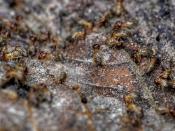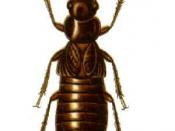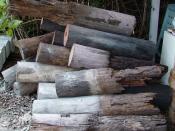All animals face the same problems in adapting to the desert. They must find shelter from daytime heat and nighttime cold, as well as find food and water, which are often scarce. Yet, in spite of these extreme conditions, most animal species are represented in the desert environment, even some we typically associate with temperate or wet surroundings.
Invertebrates
Animals without backbones are called invertebrates. They include simple desert animals such as worms, and more complex animals such as the locust. Certain groups of invertebrates must spend part of their lives in water. Generally speaking, these types are not found in deserts. One exception is the brine shrimp, an ancient species that can live in desert salt lakes. Other exceptions are certain species of worms, leeches, midges, and flies that live in the fresh water of oases and other waterholes.
Most invertebrates are better adapted to desert life than vertebrates.
Many have an exoskeleton (an external skeleton, or hard shell, made from a chemical substance called chitin [KY-tin]). Chitin is like armor and is usually waterproof. It also protects against the heat of the desert Sun, preventing its owner from drying out.
Food and water
Many invertebrates are winged and can fly considerable distances in search of food. Many eat plant foods or decaying animal matter. Some invertebrates are parasites, like the Guinea worm, which lurk at waterholes waiting for some unsuspecting animal to wander by. Parasites attach themselves to the animal's body or are swallowed and invade the animal from the inside.
The arachnids (spiders and scorpions), which are carnivores (meat eaters), seem well suited to desert life. They prey on insects and sometimes, if they are large enough, small lizards, mice, and birds. Scorpions use their pinchers to catch prey, then inject it with venom (poison) from the...


